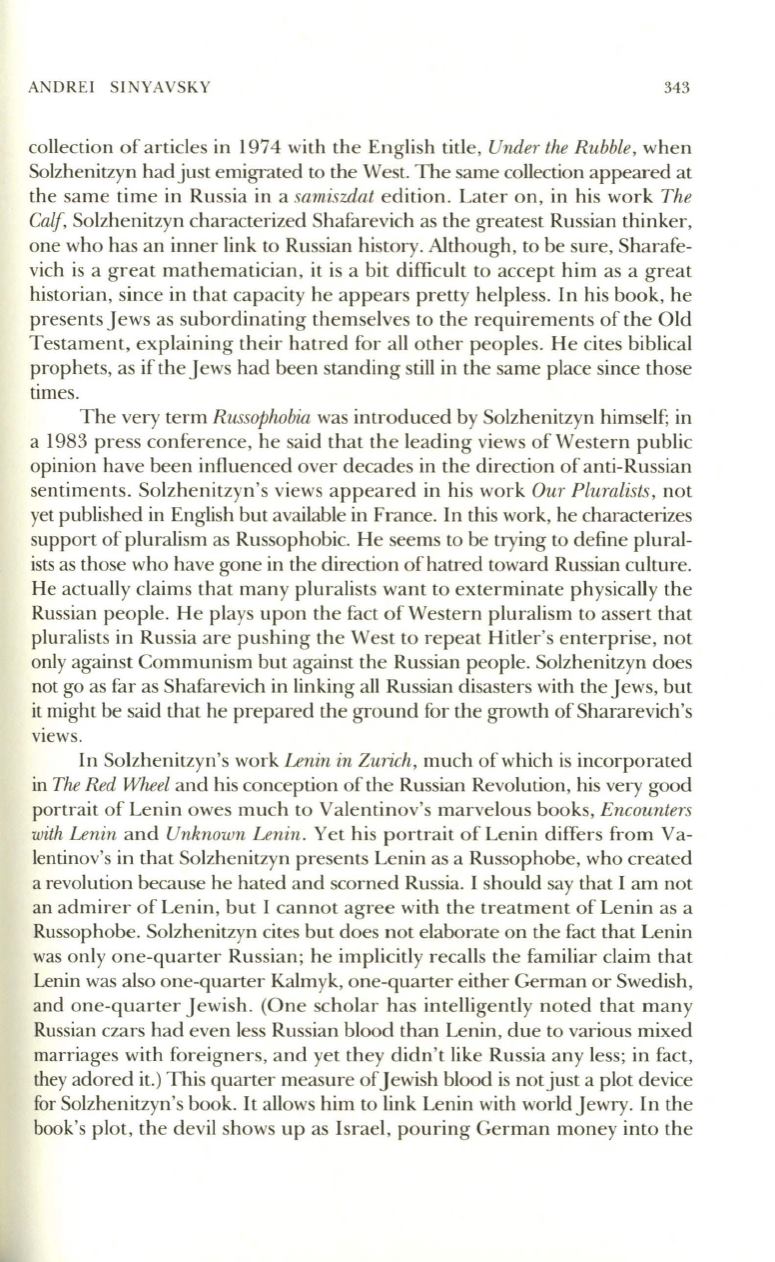
ANDREI SINYAVSKY
343
collection of articles in 1974 with the English title,
Under the Rubble,
when
Solzhenitzyn had just emigrated
to
the West. The same collection appeared at
the same time in Russia in a
samiszdat
edition. Later on, in his work
The
Calf,
Solzhenitzyn characterized Shafarevich as the greatest Russian thinker,
one who has an inner link to Russian history. Although, to be sure, Sharafe–
vich is a great mathematician, it is a bit difficult to accept him as a great
historian, since in that capacity he appears pretty helpless. In his book, he
presents Jews as subordinating themselves to the requirements of the Old
Testament, explaining their hatred for all other peoples. He cites biblical
prophets, as if the Jews had been standing still in the same place since those
times.
The very term
Russophobia
was introduced by Solzhenitzyn himself; in
a 1983 press conference, he said that the leading views of Western public
opinion have been influenced over decades in the direction of anti-Russian
sentiments. Solzhenitzyn's views appeared in his work
Our Pluralists,
not
yet published in English but available in France. In this work, he characterizes
support of pluralism as Russophobic. He seems to be trying to define plural–
ists as those who have gone in the direction of hatred toward Russian culture.
He actually claims that many pluralists want to exterminate physically the
Russian people. He plays upon the fact of Western pluralism to assert that
pluralists in Russia are pushing the West to repeat Hitler's enterprise, not
only against Communism but against the Russian people. Solzhenitzyn does
not go as far as Shafarevich in linking all Russian disasters with the Jews, but
it might be said that he prepared the ground for the growth ofShararevich's
views.
In Solzhenitzyn's work
Lenin in Zurich,
much of which is incorporated
in
The Red Wheel
and his conception of the Russian Revolution, his very good
portrait of Lenin owes much to Valentinov's marvelous books,
Encounters
with Lenin
and
Unknown Lenin.
Yet his portrait of Lenin differs from Va–
lentinov's in that Solzhenitzyn presents Lenin as a Russophobe, who created
a revolution because he hated and scorned Russia. I should say that I am not
an admirer of Lenin, but I cannot agree with the treatment of Lenin as a
Russophobe. Solzhenitzyn cites but does not elaborate on the fact that Lenin
was only one-quarter Russian; he implicitly recalls the familiar claim that
Lenin was also one-quarter Kalmyk, one-quarter either German or Swedish,
and one-quarter Jewish. (One scholar has intelligently noted that many
Russian czars had even less Russian blood than Lenin, due to various mixed
marriages with foreigners, and yet they didn't like Russia any less; in fact,
they adored it.) This quarter measure ofJewish blood is not just a plot device
for Solzhenitzyn's book.
It
allows him to link Lenin with world Jewry. In the
book's plot, the devil shows up as Israel, pouring German money into the


